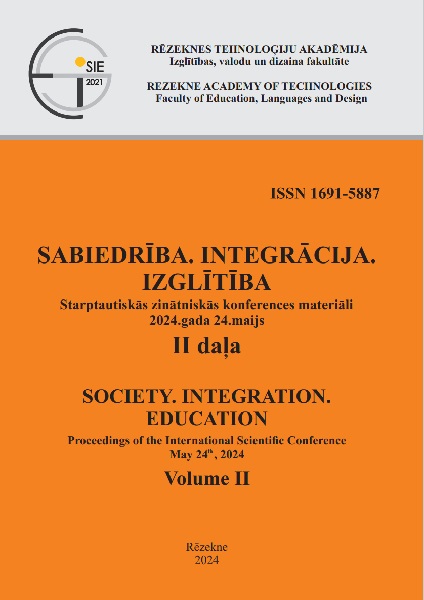DYNAMICS OF STUDENTS’ PSYCHOLOGICAL WELL-BEING
DOI:
https://doi.org/10.17770/sie2024vol2.7794Keywords:
dynamics of students, psychological well-being, adaptation, demographic and social determinants of students’ psychological well-being, gender, material security, healthAbstract
This scientific article reflects the results of research on the psychological well-being of students of Rēzekne Academy of Technologies in 2019 and 2023. The need for such studies is justified by recent studies in various countries, which show that the prevalence and severity of mental problems among young people is increasing. Taken together, these studies show that students are increasingly experiencing symptoms of increased anxiety and stress, as well as depression. Thus, the deterioration of students' psychological well-being is a major challenge in modern universities. The aim of the empirical study: to reflect the dynamics of the level and content of the psychological well-being of young students. The analysis of scientific literature and empirical results is used as a basic method in the development of the article.
References
Akhtar, S. (2015). Psychological Well-being in Students of Gender difference. The International Journal of Indian Psychology,Vol. 2 (4),153- 161.
Anic, P., Tončić, M. (2013). Orientations to Happiness, Subjective Well-being and Life Goals. Psihologijske Teme. 22 (1),135–153.
Baik, C., Naylor, R., & Arkoudis, S. (2015). The first year experience in Australian universities: Findings from two decades, 1994-2014. Melbourne, Australia: Melbourne Centre for the Study of Education.
Bexley, E., Daroesman, S., Arkoudis, S., & James, R. (2013). University Student Finances in 2012: A Study of the Financial Circumstances of Domestic and International Students in Australia’s Universities. Canberra: Universities Australia.
Boyce, C. J., Brown, G. D. A., and Moore, S. C. (2010). Money and happiness: rank of income, not income, affects life satisfaction. Psychological Sciences. 21, 471–475.
Burns, R.A., Machin, M.A. (2010). Identifying gender differences in the independent effects of personality and psychological well-being on two broad affect components of subjective well-being. Personality and Individidual Differences, 48, 22–27.
Cvetkovski, S., Reavley, N. J., & Jorm, A. F. (2012). The prevalence and correlates of psychological distress in Australian tertiary students compared to their community peers. Australian and New Zealand Journal of Psychiatry, 46(5), 457-467.
Demir, M. (2010). Close relationships and happiness among emerging adults. Journal of Happiness Studies. 11, 293–313.
Eisenberg, D., Golberstein, E., and Hunt, J.B. (2009). Mental Health and Academic Success in College.The B.E. Journal of Economic Analysis & Policy 9 (1): Article 40.
Ibrahim, A. K., Kelly, S. J., Adams, C. E., & Glazebrook, C. (2013). A systematic review of studies. Journal of Social Work Education and Practice,3(2),79-89.
Kemp, A.H., Arias, J.A., & Fisher, Z. (2018). Social ties, health and wellbeing: A literature review and model. Neuroscience and Social Science.
Larcombe, W., Finch, S., Sore, R., Murray, C. M., Kentish, S., Mulder, R. A., Baik, C.,Toklatilidis, O.& Williams, D. (2015). Prevalence and socio-demographic correlates of psychological distress among students at an Australian university. Studies in Higher Education, 1-18.
Lerkkanen, M., Nurmi, J., Vasalampi, K., Virtanen, T., & Torppa, M. (2018). Changes in students’ psychological well-being during transition from primary school to lower secondary school: a person-centered approach. Learning and Individual Differences, 69, 138–149.
Nepomuceno, B.B, Cardoso, A.A., Ximenes, V.M., Barros, J.P., Leite, J.F. (2016). Mental health, well-being, and poverty: A study in urban and rural communities in Northeastern Brazil. Journal of Prevention & Interview in the Community, 44(1),63-75.
Özdemir, U., @ Tuncay, T. (2008). Correlates of loneliness among university students. Child and Adolescence Psychiatry and Mental Health, 2, 29–39.
Ryff, C. D. (2017). Eudaimonic well-being, inequality, and health: recent findings and future directions. International Review of Economics,64, 159–178.
Ryff, C. D. (2014). Psychological well-being revisited: advances in the science and practice of eudaimonia. Psychotheraphy and Psychosomatics. 83, 10–28.
Ryff, C. D., & Keyes, C. L. (1995). The Structure of Psychological Well-Being Revisited. Journal of Personality and Social Psychology,69 (4), 719 – 27.
Sarokhani, D., Delpisheh, A., Veisani, Y., Sarokhani, M. T., Manesh, R. E., & Sayehmiri, K.(2013). Prevalence of depression among university students: a systematic review and meta-analysis study. Depression research and treatment, 373-857.
Schofield, M.J., Halloran, P., McLean, S.A., Knauss, F. C., & Paxton, S.J. (2016). Depressive symptoms among Australian university students: Who is at risk?. Australian Psychologist, 51(2).
Shaw, M., Dorling D. and Mitchell, R. (2002). Health, Place and Society. Pearson: London.
Slavin, S. J., Schindler, D. L., & Chibnall, J. T. (2014). Medical student mental health 3.0:improving student wellness through curricular changes. Academic Medicine, 89(4), 573-577.
Tommis, Y., Seddon, D., Woods, B., Robinson, C.A., Reeves, C., Russell, I.T. (2007).Rural-urban differences in the effects on mental well-being of caring for people with stroke or dementia. Aging Ment Health,11(6),743-50.
Viejo, C., Gómez-López, M., & Ortega-Ruiz, R. (2018). Adolescents’ psychological well- being: a multidimensional measure. International Journal of Environmental Research and Public Health,15 (10):23-25.






